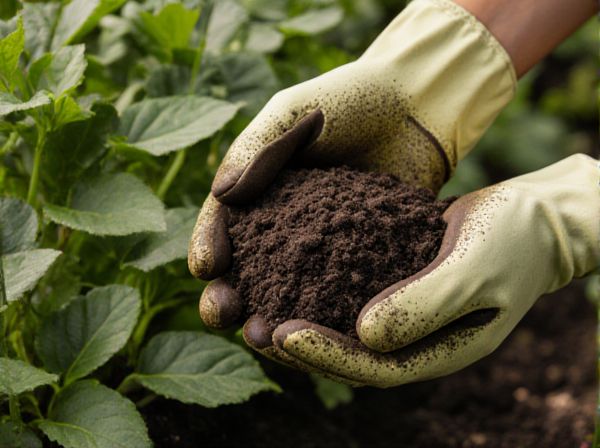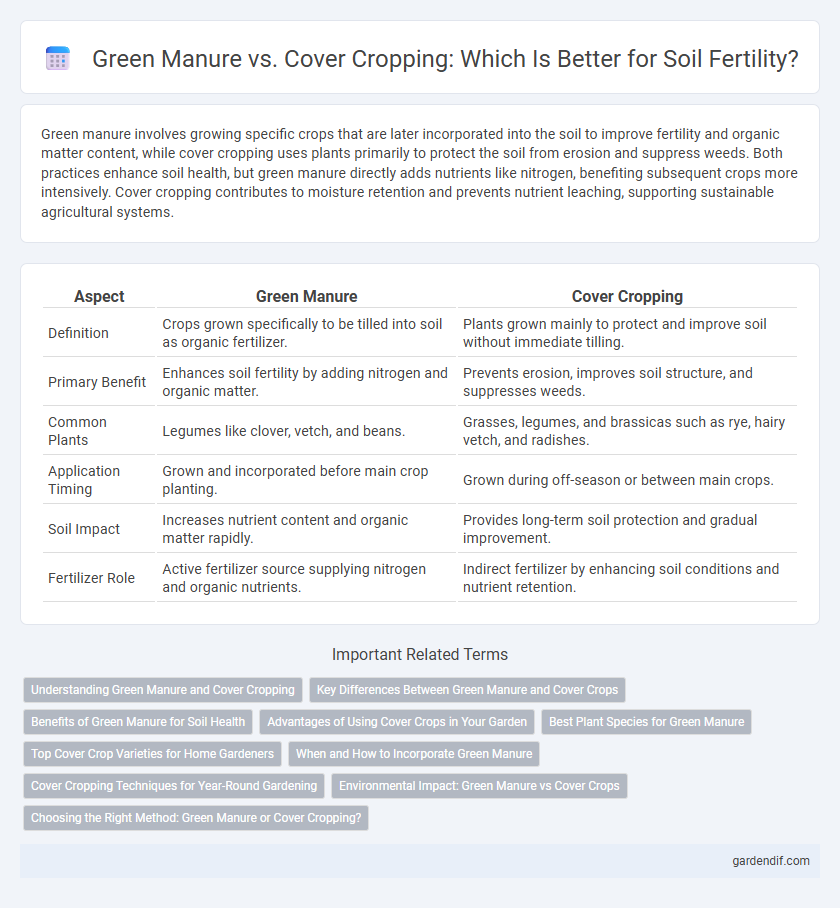
Green manure vs Cover cropping Illustration
Green manure involves growing specific crops that are later incorporated into the soil to improve fertility and organic matter content, while cover cropping uses plants primarily to protect the soil from erosion and suppress weeds. Both practices enhance soil health, but green manure directly adds nutrients like nitrogen, benefiting subsequent crops more intensively. Cover cropping contributes to moisture retention and prevents nutrient leaching, supporting sustainable agricultural systems.
Table of Comparison
| Aspect | Green Manure | Cover Cropping |
|---|---|---|
| Definition | Crops grown specifically to be tilled into soil as organic fertilizer. | Plants grown mainly to protect and improve soil without immediate tilling. |
| Primary Benefit | Enhances soil fertility by adding nitrogen and organic matter. | Prevents erosion, improves soil structure, and suppresses weeds. |
| Common Plants | Legumes like clover, vetch, and beans. | Grasses, legumes, and brassicas such as rye, hairy vetch, and radishes. |
| Application Timing | Grown and incorporated before main crop planting. | Grown during off-season or between main crops. |
| Soil Impact | Increases nutrient content and organic matter rapidly. | Provides long-term soil protection and gradual improvement. |
| Fertilizer Role | Active fertilizer source supplying nitrogen and organic nutrients. | Indirect fertilizer by enhancing soil conditions and nutrient retention. |
Understanding Green Manure and Cover Cropping
Green manure involves growing specific crops such as clover or alfalfa, which are then plowed back into the soil to enrich it with organic matter and nitrogen. Cover cropping utilizes plants like rye or vetch to protect the soil from erosion, improve soil structure, and suppress weeds during off-season periods. Both practices enhance soil fertility and promote sustainable agriculture by increasing nutrient retention and microbial activity.
Key Differences Between Green Manure and Cover Crops
Green manure refers specifically to crops grown to be incorporated into the soil to improve fertility by adding organic matter and nitrogen, often legumes like clover or vetch. Cover cropping includes a broader range of plants grown primarily to protect soil from erosion, suppress weeds, and enhance water retention, such as rye, oats, or mustard. The key difference lies in green manure's primary purpose of soil enrichment through decomposition, while cover crops serve multiple agronomic functions beyond nutrient addition.
Benefits of Green Manure for Soil Health
Green manure enhances soil health by increasing organic matter, boosting microbial activity, and improving soil structure, which enhances water retention and nutrient availability. It also fixes atmospheric nitrogen, reducing the need for synthetic fertilizers and promoting sustainable crop growth. Compared to cover cropping, green manure is often specifically grown and incorporated into the soil, delivering concentrated benefits for nutrient cycling and soil fertility.
Advantages of Using Cover Crops in Your Garden
Cover crops enhance soil fertility by fixing nitrogen, improving organic matter content, and reducing nutrient leaching. Their root systems prevent soil erosion and increase water retention, promoting healthier plant growth. Integrating cover cropping in your garden boosts biodiversity, suppresses weeds, and supports beneficial soil microorganisms for sustainable soil health.
Best Plant Species for Green Manure
Leguminous plants such as clover, vetch, and cowpeas are among the best species for green manure due to their nitrogen-fixing capabilities that enhance soil fertility naturally. Non-leguminous options like rye and buckwheat contribute to organic matter buildup and weed suppression, improving soil structure. Selecting plant species based on soil type, climate, and cropping system optimizes nutrient cycling and crop yield in sustainable agriculture practices.
Top Cover Crop Varieties for Home Gardeners
Top cover crop varieties for home gardeners include legumes like clover and vetch, which fix nitrogen and improve soil fertility naturally. Buckwheat and ryegrass are also popular for their ability to suppress weeds, enhance organic matter, and prevent erosion. Incorporating green manure crops such as hairy vetch or Austrian winter peas boosts nutrient cycling and promotes healthy soil structure in vegetable beds.
When and How to Incorporate Green Manure
Green manure crops, such as clover and legumes, should be incorporated into the soil before flowering to maximize nitrogen fixation and nutrient availability for subsequent crops. Incorporation is best done by cutting and tilling the green manure into the soil 2-3 weeks before planting the next crop, allowing time for decomposition and nutrient release. Proper timing enhances soil organic matter, improves soil structure, and reduces the need for synthetic fertilizers.
Cover Cropping Techniques for Year-Round Gardening
Cover cropping techniques for year-round gardening involve planting specific crops like clover, rye, or vetch during off-seasons to enhance soil fertility, prevent erosion, and suppress weeds. These cover crops increase organic matter and nitrogen levels naturally, reducing the need for synthetic fertilizers and improving soil structure. Integrating diverse cover crops in rotation schedules maximizes nutrient cycling and supports sustainable soil health throughout the year.
Environmental Impact: Green Manure vs Cover Crops
Green manure enhances soil fertility by decomposing rapidly, increasing organic matter and nitrogen availability, which reduces the need for synthetic fertilizers and mitigates greenhouse gas emissions. Cover crops primarily prevent soil erosion, improve water retention, and suppress weeds, contributing to biodiversity and carbon sequestration but with less direct nutrient input than green manure. Both practices support sustainable agriculture by improving soil health and reducing environmental pollution through different ecological mechanisms.
Choosing the Right Method: Green Manure or Cover Cropping?
Selecting between green manure and cover cropping depends on soil health goals and crop rotation plans. Green manure crops, such as legumes, fix nitrogen to improve soil fertility rapidly, while cover crops primarily prevent erosion and suppress weeds during off-seasons. Evaluating factors like nutrient needs, planting schedule, and long-term soil structure benefits ensures the optimal fertilization strategy for sustainable agriculture.
Green manure vs Cover cropping Infographic

 gardendif.com
gardendif.com